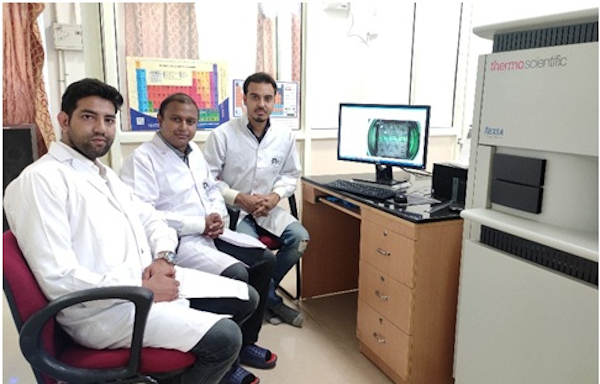Researchers from the Indian Institute of Technology (IIT) Mandi, in collaboration with researchers from Yogi Vemana University, have designed a novel photocatalyst that can remove pollutants from water while simultaneously generating hydrogen using sunlight.
The researchers have designed a series of novel and multifunctional nanocomposite photocatalysts by coupling mesocrystals of calcium titanate with edge sulphur atoms enriched molybdenum disulphide and reduced graphene oxide. A specific and useful example of a photocatalytic reaction is the splitting of water into hydrogen and oxygen. Although this reaction was demonstrated as early as 1972 by Fujishima and Honda, the inefficiency of the process has been a bottleneck in scaling up the technology for practical applications. In addition, the researchers have also used these photocatalysts in the degradation of organic pollutants found in water.
“The performance of a photocatalytic reaction depends upon the efficiency with which the photocatalyst converts light energy into photogenerated charges that drives the reaction of interest,” explains Dr Venkata Krishnan, Associate Professor, School of Basic Sciences, IIT Mandi. Photocatalysts work by generating electron-hole pairs when exposed to light of specific wavelengths, which induces the reaction they are meant to catalyze. Oxide materials such as titania and titanates are commonly studied photocatalysts, but these materials are often inefficient by themselves because the electrons and holes combine before the reaction can be propelled forward.
“Mesocrystals, a new class of ‘superstructures’ made of highly ordered nanoparticles, could limit the recombination of electron-hole pairs because the free electrons that are generated flow between particles before they can recombine with the hole,” says Dr. Venkata Krishnan.
“The performance of a photocatalytic reaction depends upon the efficiency with which the photocatalyst converts light energy into photogenerated charges that drives the reaction of interest,”
“Our combination showed a 33-fold enhanced photocatalytic hydrogen evolution over pure calcium titanate, with apparent light-to-electron conversion efficiencies of 5.4%, 3.0% and 17.7% for light of three different wavelengths, orange light (600 nm wavelength) producing the highest efficiency”, says Dr. Venkata Krishnan. The mesocrystal-semiconductor-graphene combination also degrades many kinds of organic pollutants when exposed to light, which makes it promising for pollution control techniques.

Dr. Venkata Krishnan attributes the enhancement in photocatalytic performance of their material combination, to three factors: (a) the intimate contact between the three components, which leads to better electron transfer; (b) the high surface area that provides more space for the reaction to take place; and (c) specific sites on molybdenum disulphide (MoS2) that act as sticky sites for the positive hydrogen ions that are generated during the reaction, which, in turn, enhances hydrogen production.
It may be known that graphene is the new “wonder-material” in the field of materials science, ever since its isolation earned the Nobel Prize in 2010. The scientists at IIT Mandi found that remarkable enhancement in photocatalytic activity could be achieved with this combination.
The results of their work have been published in the journal ChemPhotoChem. The research team comprises Dr. Venkata Krishnan, Associate Professor (Chemistry), School of Basic Sciences, IIT Mandi, his research scholars Mr. Ashish Kumar and Mr. Ajay Kumar from IIT Mandi; and Dr. M. V. Shankar from Yogi Vemana University along with his research scholar Mr. Vempuluru Navakoteswara Rao.
Source: Vigyan Prasar
Image Courtesy: Vigyan Prasar
You may also like
-
New Heat-Based Approach To Cancer Treatment Can Reduce Chemotherapy Doses
-
Scientists Take A Major Step Towards Unification Of Classical & Quantum Gravity
-
India Graphene Engineering and Innovation Centre (IGEIC) Under the Vision of Viksit Bharat@2047 Launched
-
New High-Performance Gas Sensor can Monitor Low Level Nitrogen Oxides Pollution
-
Antidepressant Drug can be Repurposed for Treating Breast Cancer